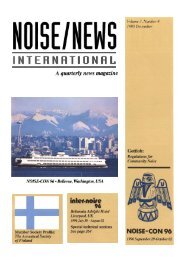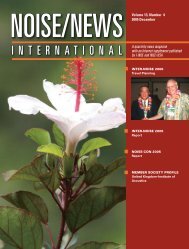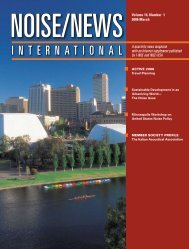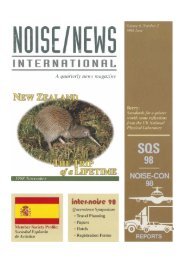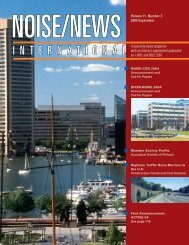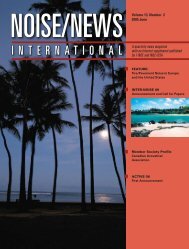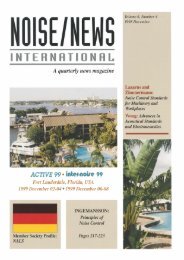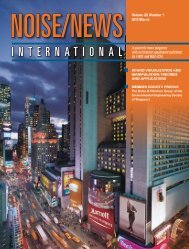Volume 15, Number 4, December, 2007 - Noise News International
Volume 15, Number 4, December, 2007 - Noise News International
Volume 15, Number 4, December, 2007 - Noise News International
- No tags were found...
You also want an ePaper? Increase the reach of your titles
YUMPU automatically turns print PDFs into web optimized ePapers that Google loves.
C: (Bill Lang) So the definition ofsoundscape may have a culturalinterpretation which one must recognize.C: (Kjell Spång) We define soundscapein our program as the sound variationin space and time caused by thetopography of the city and differentsound sources. We differentiatebetween acoustic soundscapes,which is what we can measure withour acoustical instruments, and theperceived soundscape where we needperceptual methods to measure thequality of the sound environment. Sothe definition of a sound environmentis a bit broader than that of asoundscape. The difference is that asound environment is a static situation,whereas the soundscape conceptincludes time variation as part of it. Iagree with you that there are differentinterpretations of soundscapes, andthat’s one of the problems that we havewith promoting positive soundscapes.When we talk with politicians or thecommunity people, they have difficultiesin understanding what we mean bysoundscapes. Sound environment iseasier for them because they are familiarwith the term environment.C: (Bill Lang) I don’t see any culturalelement in your definition. I think thatwas what Prof. Tachibana referred to.C: (Kjell Spång) Yes, that is the differencebetween the way we use it and theway some others do. Our approach ismore technical. The reason that weuse soundscape is that it goes beyondwhat we can measure with acousticalinstruments.Q: Kjell Spång, I’m curious about the silentside of buildings and whether there’sany economics to the annoyance that’sreferred to and the response of people.A: Part of our study is based on interviewswith many people living along the sameroad with the same traffic where someof the houses had access to a silent sideand some did not, depending on howthey face the street. We were able tocompare the effect; that’s where we getthe 50 percent figure. We investigatedfive different areas like thatand they went from 65 dBdown to around 50 dB onthe exposed side.C: (David Lubman) Thereare positive aspects tosoundscape that you mightconsider besides areasof quiet. We don’t wantsilence. When RachaelCarson wrote Silent Spring,the book that started themodern environmentalmovement, silence wasdeath. So silence wasn’tall that good. But thereare other things that,if the environment isquiet enough, you canhear. Things that bringpleasure and joy and thatare culturally related.For example, if it’s quietenough you can install a children’ssound playground so children can enjoyplaying with sounds and listening tothem. One example of the culturalaspect of a soundscape is in Englandwhere they have sound neighborhoods.When the Church of Bow Bells(Church of St. Mary-Le-Bow) wasbuilt in London, its bells created asound neighborhood. Everyone inhearing range of the bells lives in thatsound neighborhood. That defined theCockney ethnicity and anyone bornwithin the sound of Bow Bells was aCockney. Some nursery rhymes arebased on this, e.g. “Oranges and lemonssay the bells of St. Clemens.”C: (Kjell Spång) This program isinterdisciplinary. We have acousticians,medical personnel, and psychologists.The psychologists are best qualified todefine positive soundscapes, and theyWhen we talk withpoliticians or thecommunity people,they have difficulties inunderstanding what wemean by soundscapes.Sound environment iseasier for them becausethey are familiar with theterm environment.have developed a system of perceptionmeasurements based on technologyusing neural metrics. This study hasalso included aspects of social lifein residential areas. There is littlesocial life if one cannot beoutdoors in a reasonablypleasant environment.C: (Bill Lang) This relatesto an aspect that we talkedabout earlier today, namelythat the FAA in this countryis spending something likeUSD 500 million a year onsound insulation of housesaround airports, but thatdoesn’t allow the individualto use the backyard for asocial gathering outdoors.We are sealing the housesbetter, but they have to stayindoors to enjoy the quiet.Cardiovascular Diseaseand Ototoxic ChemicalsQ: Bob Bruce, whatare your thoughts aboutthe growing scientificevidence of other health outcomes ofoccupational noise exposure such ascardiovascular diseases and accidents?What is the impact of this newknowledge on exposure limits?A: I don’t have a lot of experiencein that area. We’ve looked at thecombination of noise and chemicals;the double exposure seems to enhancethe likelihood of problems. Hearingloss can occur at lower sound levelswhen one is exposed to chemicals.Although I haven’t seen evidence thata combination of noise and vibrationmay cause cardiovascular disease, somesuggest that this is possible.Office Masking <strong>Noise</strong>Q: Bob Bruce, in addition to what youreported about office workers, haveyou considered the impact of officemasking noise?<strong>2007</strong> <strong>December</strong> www.inceusa.org • www.noisenewsinternational.net • www.i-ince.org145



